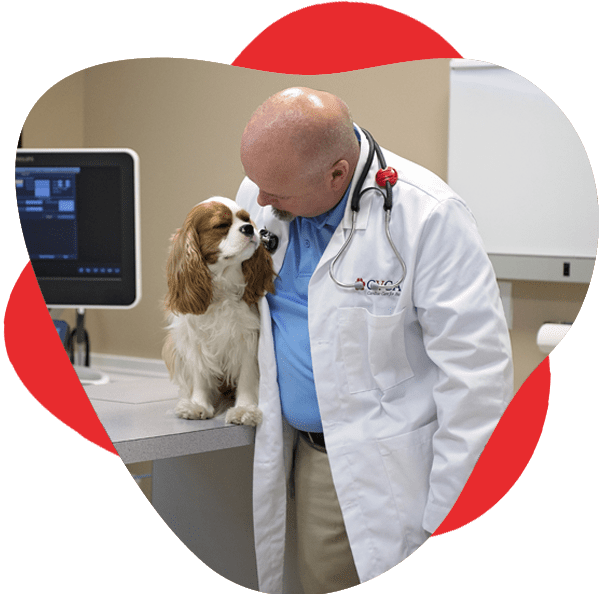What You Need to Find Out About Veterinary Solutions: An Overview of Diagnostic Devices and Procedures
Veterinary solutions play an essential function in keeping the wellness of pet dogs. Normal check-ups can expose hidden wellness worries early. Numerous analysis devices and procedures, such as blood tests and imaging strategies, supply essential understandings right into an animal's wellness. Recognizing these approaches is crucial for pet dog owners. What specific diagnostic treatments are most commonly utilized, and exactly how can they affect a pet's therapy plan?
Value of Regular Veterinary Exams
While several pet dog owners might undervalue the importance of routine vet examinations, these appointments are necessary for maintaining an animal's overall health. Routine visits to the veterinarian enable for very early discovery of potential health problems prior to they rise right into major troubles. Normal examinations often include vaccinations, which are vital for preventing contagious illness that could drastically impact a pet's well-being. In addition, these visits give an opportunity for veterinarians to evaluate the pet's weight, oral health, and general condition, guaranteeing that the pet dog is thriving. During these gos to, family pet owners can likewise receive important guidance on diet regimen, exercise, and precautionary care customized to their details animal's requirements.
Typical Analysis Procedures in Veterinary Medicine
In veterinary medicine, precise diagnosis is necessary for effective therapy. Typical diagnostic procedures include blood testing strategies, advanced imaging technologies, and urinalysis, each playing a substantial role in determining wellness problems. Understanding these techniques improves the ability to offer suitable treatment for animal people.
Blood Evaluating Strategies
Blood screening techniques work as necessary diagnostic tools in vet medication, allowing vets to assess the health and wellness of pets precisely. These methods entail collecting blood samples to evaluate numerous components, such as white and red blood cells, platelets, and biochemical markers. Usual examinations consist of complete blood matters (CBC), which review total health and wellness and identify infections, and biochemical panels, which examine body organ feature and metabolic condition. In addition, serological examinations can recognize certain conditions through antibody detection. Blood screening is minimally invasive and offers important information that assists in identifying problems, monitoring health condition, and assessing feedbacks to therapies. On the whole, these techniques play an important duty in making certain optimal care for pets and livestock alike.
Imaging Technologies Utilized
Diagnostic imaging innovations are essential devices in vet medication, complementing blood testing techniques by giving aesthetic understandings into an animal's internal structures. Common imaging methods consist of X-rays, which work for examining bone cracks and detecting foreign objects, and ultrasound, which permits real-time visualization of soft tissues and body organs. Magnetic vibration imaging (MRI) uses comprehensive photos of intricate physiological areas, especially in neurological assessments. Computed tomography (CT) provides cross-sectional images, enhancing analysis precision for different problems. Each of these technologies help veterinarians in detecting health problems, intending treatments, and checking recovery. By including imaging modern technologies, veterinary experts can better examine an animal's health and wellness and make notified decisions concerning their care.
Urinalysis and Diagnostics
Urinalysis works as a crucial diagnostic tool in vet medication, giving useful understandings into a pet's general health and helping in the discovery of numerous conditions. This non-invasive treatment examines pee samples to evaluate kidney feature, hydration status, and metabolic problems. Typical parts checked out include particular gravity, pH levels, sugar, healthy proteins, and the presence of blood or bacteria. Irregular findings can indicate concerns such as urinary system system infections, diabetic issues mellitus, or kidney illness. To boost analysis precision, urinalysis is frequently performed combined with various other tests, such as blood job and imaging studies. Early detection through urinalysis can cause timely treatments, improving the diagnosis for many vet clients. For that reason, it is a necessary element of detailed veterinary care.
Comprehending Blood Examinations and Laboratory Analysis
Understanding blood tests and research laboratory analysis is essential in veterinary medication as it helps in diagnosing various health and wellness conditions in animals. Various kinds of blood examinations offer essential details about a pet's internal state, while translating laboratory results requires mindful consideration of numerous variables. This area will certainly explore the kinds of blood tests offered and the value of their results.
Kinds of Blood Examinations
Blood tests play a vital duty in veterinary medicine, giving necessary insights right into a pet's health and wellness standing. Different kinds of blood tests are utilized, each offering various purposes. Total blood counts (CBC) assess general health and wellness and identify conditions such as anemia or infection. Biochemical profiles examine body organ feature by measuring electrolytes and enzymes, using insights right into metabolic health and wellness. Serological examinations identify specific antibodies or microorganisms, aiding in the diagnosis of infections or autoimmune conditions. Blood keying assurances risk-free transfusions, while coagulation tests gauge the blood's ability to embolisms, important for procedures. These tests jointly enhance diagnosis, treatment preparation, and tracking of a pet's wellness, showing the relevance of comprehensive laboratory analysis in vet care.

Interpreting Laboratory Results
A detailed analysis of lab outcomes is essential for exact medical diagnosis and therapy in veterinary medication. Interpreting lab results needs an understanding of regular referral ranges and the significance of deviations. Blood examinations can disclose different wellness indicators, such as organ function, electrolyte balance, and the presence of infections. Veterinarians must think about the whole scientific photo, consisting of the animal's background, physical evaluation searchings for, and any signs presented. Variants in results may develop from aspects such as age, breed, and underlying health problems. As a result, lab results must not be viewed in seclusion however instead as component of an all-encompassing diagnostic method. Precise analysis permits for tailored treatment plans and better end results for veterinary individuals.
Imaging Techniques: X-rays, Ultrasounds, and Beyond
Imaging strategies are necessary devices in vet medicine, supplying critical understandings into the health and well-being of animals. Amongst one of the most commonly used techniques are X-rays and ultrasounds. X-rays are vital for imagining bone frameworks, helping vets identify fractures, tumors, or international objects. This approach is non-invasive and quick, making it excellent for urgent situations.Ultrasounds, on the other hand, use acoustic waves to create pictures of soft tissues and body organs. This method is particularly helpful for taking a look at the heart, abdominal area, and reproductive body organs, allowing vets to assess problems like liquid build-up or body organ abnormalities.Beyond X-rays and ultrasounds, progressed imaging methods such as computed tomography (CT) and magnetic vibration imaging (MRI) are progressively used in veterinary method. These methods supply comprehensive cross-sectional images, enhancing the accuracy of diagnoses and treatment plans. CT Scans For Animals. In general, imaging strategies play a vital function in ensuring efficient vet care
The Duty of Biopsies in Diagnosing Pet Health Issues
Precision in diagnosing wellness concerns in animals frequently pivots on using biopsies, which give definitive info concerning tissue abnormalities. A biopsy includes the elimination of a little sample of tissue for assessment under a microscopic lense, allowing vets to identify various problems, consisting of infections, lumps, and inflammatory conditions. This diagnostic tool is necessary for identifying in between malignant and benign growths, basics assisting treatment decisions, and assessing the seriousness of a condition.Biopsies can be carried out making use of various methods, such as needle ambition, incisional biopsies, or excisional biopsies, depending upon the location and sort of cells involved. The option of technique might influence healing time and the quantity of tissue collected. Ultimately, the information amassed from a biopsy can result in targeted treatments, enhancing results for animals dealing with significant health and visit the website wellness obstacles. Vets emphasize the significance of this procedure in achieving precise diagnoses and reliable therapy plans.
Advanced Diagnostic Equipment: Endoscopy and CT Checks

Advanced diagnostic tools, such as endoscopy and CT scans, play a crucial function in modern veterinary medicine, supplying non-invasive techniques to picture internal frameworks and identify various conditions in pets. Endoscopy involves the usage of a flexible tube outfitted with a camera, allowing veterinarians to check out the gastrointestinal system and breathing system directly. This method can reveal irregularities such as lumps, foreign bodies, or inflammation, enabling targeted treatment plans.CT scans, on the other hand, make use of sophisticated imaging innovation to produce comprehensive cross-sectional pictures of the body (Cancer Veterinary Near Me). This approach is particularly valuable for evaluating complicated structures like the brain, spine, and joints. By supplying high-resolution images, CT scans aid vets in recognizing issues that might not appear with typical radiography. With each other, these advanced tools boost analysis precision, boost therapy end results, and eventually add to much better total pet dog health administration

Interpreting Examination Outcomes: What Family Pet Owners Ought To Know
Understanding test outcomes can be a difficult task for animal proprietors, specifically after innovative procedures like endoscopy and CT scans have actually been executed. Interpreting these results calls for an understanding of clinical terminology and a clear understanding of what the searchings for suggest about the animal's health and wellness. Vets frequently supply explanations, yet the intricacy of the results can still result in confusion.Pet proprietors need to actively take part in discussions with their veterinarians, asking concerns to clear up any kind of uncertainties. It is necessary to comprehend uncommon versus normal results and the ramifications for the animal's treatment plan. Additionally, recognizing that some results may call for further screening or monitoring can aid owners remain informed about their animal's health and wellness trip. Eventually, a collective technique in between animal proprietors and vet experts cultivates far better wellness results and boosts the general care experience for animals.
Frequently Asked Concerns
Exactly how Do I Choose the Right Vet Clinic for My Animal?
Picking the right veterinary center includes looking into regional options, examining credentials, visiting centers, and examining staff communications (CT Scans For Dogs). Focusing on suggestions from relied on sources can help assure the most effective care and atmosphere for an animal's health demands
What Should I Do if My Animal Declines to head to the Vet?
When a pet dog rejects to head to the vet, it's a good idea to continue to be calm, usage treats or toys to lure them, and take into consideration setting up a home go to if anxiety continues. Perseverance and favorable reinforcement are crucial.
Exist Telehealth Options for Vet Services?
Telehealth options for veterinary services are increasingly visit homepage available, permitting pet dog proprietors to seek advice from with vets from another location. These solutions make it possible for conversations concerning health and wellness concerns, recommendations on minor conditions, and follow-ups without requiring to check out a center.
How Commonly Should My Animal Have Dental Examinations?
The regularity of oral exams for pets normally relies on their age and breed. Usually, vets suggest annual oral evaluations, although some pets may need even more regular sees to keep perfect dental wellness.

What Are the Costs Related To Vet Diagnostics?
The costs connected with veterinary diagnostics can differ extensively, typically ranging from basic tests like blood work to innovative imaging strategies. Factors influencing expenditures consist of the facility's location, devices made use of, and specific examinations needed for every family pet. Veterinary solutions play an essential duty in maintaining the wellness of family pets. While several pet proprietors may take too lightly the value of regular vet exams, these consultations are vital for maintaining a pet's general wellness. Additionally, these visits offer an opportunity for veterinarians to assess the pet's weight, oral wellness, and total condition, guaranteeing that the animal is thriving. Accuracy in detecting wellness concerns in pet dogs frequently pivots on the usage of biopsies, which offer definitive information concerning cells problems. In addition, identifying that some results might require further screening or monitoring can assist owners stay informed concerning their pet dog's health and wellness journey.
Comments on “Finding the Right Cancer Veterinary Near Me: A Pet Owner’s Checklist}”